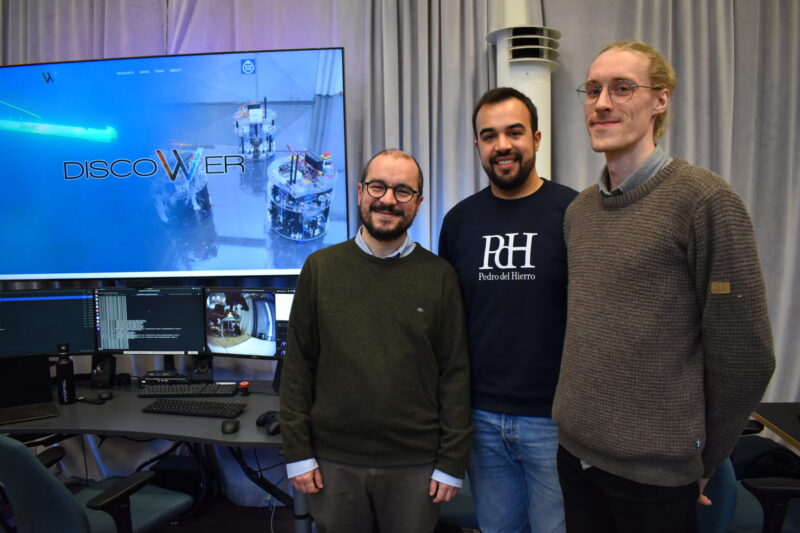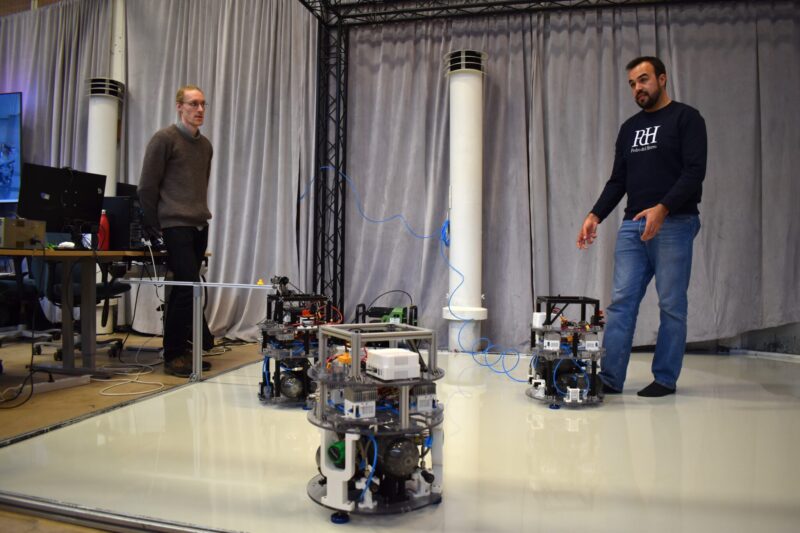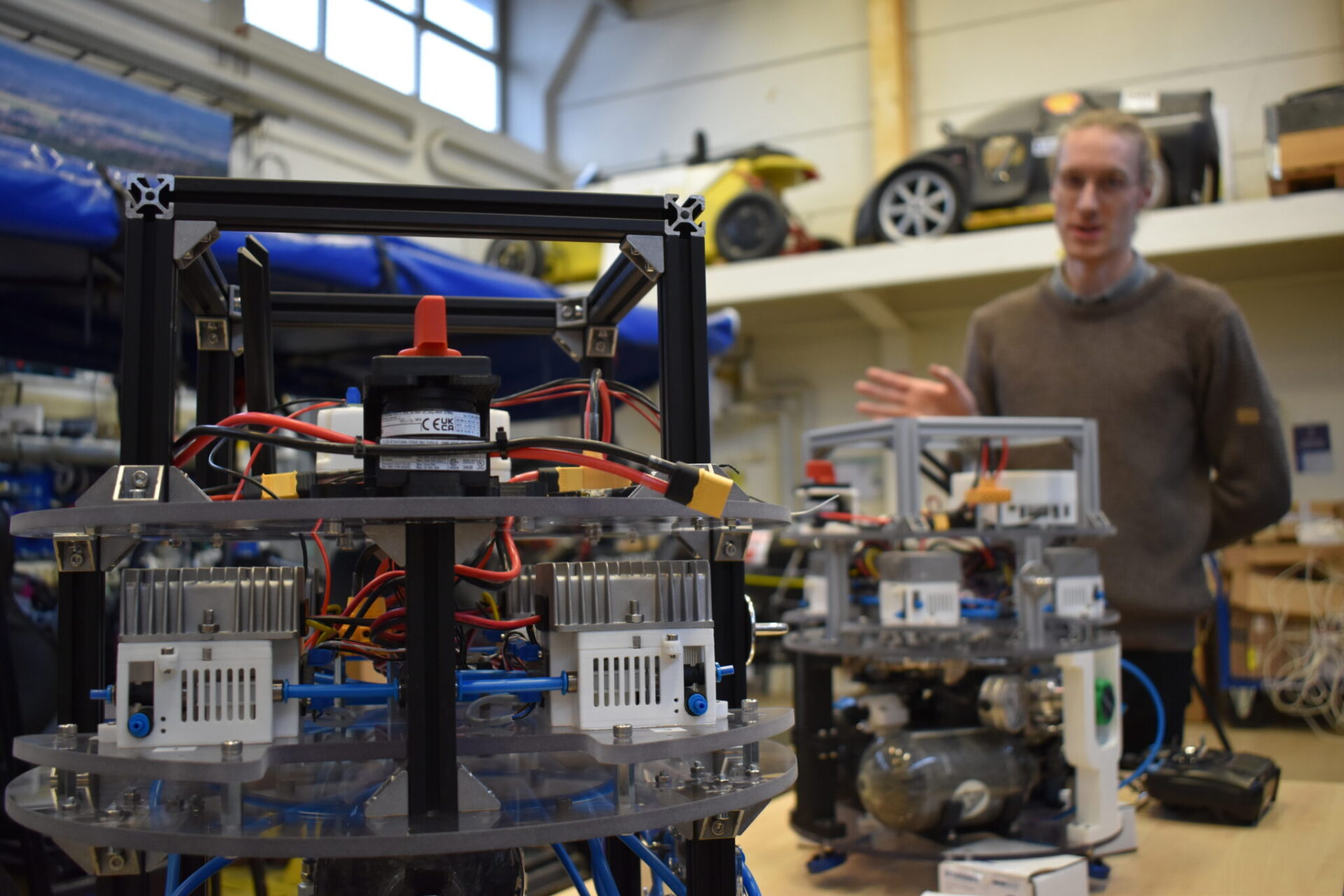At a newly opened lab at KTH, space robots are training to navigate in weightless environments. The lab is one of the biggest of its kind in Europe and was built by the team in the WASP NEST-project DISCOWER. The software used by the space robots is directly connected to NASA.
The goal? To develop software and hardware for autonomous robots capable of navigating autonomously in weightless environments – space and subsea conditions.
“I’ve long believed that underwater and space robotics share a common challenge: unconventional gravitational conditions. Buoyancy in water and weightlessness in space present similar hurdles. Testing autonomous systems, where robots move independently without direct human control, in these environments is difficult or impossible”, says Dimos Dimarogonas, professor in automatic control at KTH.
The challenge of testing means that there has previously been limited research on multi-robot systems operating autonomously in weightless environments, Pedro Roque, PhD student in the project, explains. In fact, the DISCOWER lab is one of the first of its kind in Europe, Pedro Roque continues, that directly looks at the combination of the two environments:
“With this new laboratory within our project, we can help bridge the research gap. We have constructed a two-dimensional simulation of space to address multi-robot systems research. Here, we can train both software and hardware for autonomous robots in multi-robot systems in an environment that closely resembles space, and later on will be integrated with underwater facilities being built. This way, we can improve the technology for controlling and planning multi-robot systems in various environments.”

Part of the DISCOWER team. From left: Professor Dimos Dimarogonas (KTH), PhD student Pedro Roque (KTH) and PhD student Elias Krantz (KTH).
The project came to life after Dimos Dimarogonas had discussions with Ivan Stenius, an associate professor in marine technology, who thought that this was a great idea. Then, Christer Fuglesang, professor in Space travel at KTH, and first Swedish astronaut, and Jana Tumova, an associate professor of robotics at RPL (robotics, perception, and learning), also joined the team.
The four of them are now all project leaders of the NEST-project “DISCOWER – Unification of space and underwater workspaces through a multi-agent systems approach”, with PhD students Elias Krantz, Pedro Roque, Joris Verhagen and David Dörner as part of the team.
Slippery floor for the spacebots
The project team, along with master students, have built three small robots that they are calling spacebots; robots generally termed free-flyers.
So, how do you create a weightless-like environment for the space bots to move in? The lab has three main components, Elias and Pedro explain. The first is the floor, made of epoxy, which must be as smooth and level as possible so the three space bots can move without friction (via levitation) and imitate microgravity motions.
The second component consists of support systems, mainly the motion capture system made by Qualisys, which consists of six cameras providing ground truth to the robots, and compressors that allow for the uninterrupted operation of space robots. The third and final are the platforms:
Puffs of air make the spacebots move
“The compressed air thrusters mimic the thrusters you would see on a spacecraft: by releasing puffs of air in one direction, they make the spacebots move in another direction. On a spacecraft, they would not use compressed air but some other system; but that is not something we can use in this lab because it would not be safe”, said Pedro Roque.
“Right now, the spacebots are controlled remotely by the research team, but the goal of the project is to have all three of them moving around together autonomously in harmony”, says Elias Krantz, PhD student in the project.
Space and underwater
Professor Dimos Dimarogonas said they have simultaneously been working on algorithm development and improving experimental facilities:
“Our focus is on finding effective arguments for both environments – space and underwater. Additionally, we are enhancing hardware and facilities to a point where we can begin testing algorithms. This is our current status.”

Spacebots in action. From left: PhD student Elias Krantz (KTH) and PhD student Pedro Roque (KTH).
The underwater environments, where the robots would act in reality later on, would they be on Earth?
“For now, yes. But Earth is not the only underwater environment that space engineering is aiming for. Right now, we need to test on earth, but being research, we will see where we can apply it”, Pedro Roque concludes.
Inside the DISCOWER lab
NASA-collaboration
As part of the Astrobee project, NASA has three robots operating on the International Space Station. To have the same software in the lab at KTH as the one running the robots on the space station, the team at KTH interacts with the Intelligent Robotics Group, part of the Intelligent Systems Division, at NASA Ames.
This involves replicating both high-level (Astrobee Software Packages) and low-level (PX4-based Firmware) components, allowing for comprehensive software testing before deployment. The low-level control manages tasks like battery monitoring and thruster commands, while the high-level component focuses on algorithmic control and planning. This integration enables simulation for testing mirroring real-world conditions.
FleetMQ software
The ground control station in the laboratory uses FleetMQ software, which is a WASP LaunchPad startup led by WASP PhD Student Frank Jiang.
NEST Environments
WASP supports nine multidisciplinary world-leading research environments and networks within AI, Autonomous Systems, and Software, characterized by Novelty, Excellence, Synergy, and Team, NEST.
Published: April 18th, 2024



